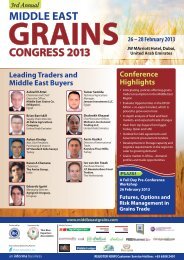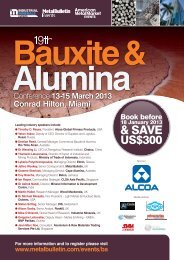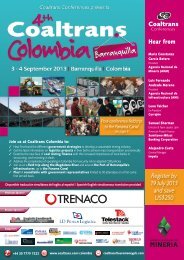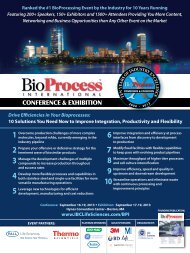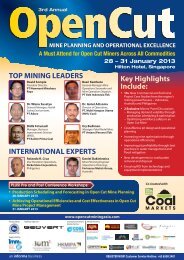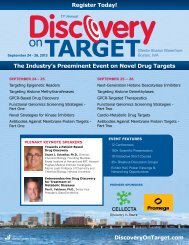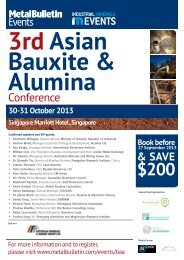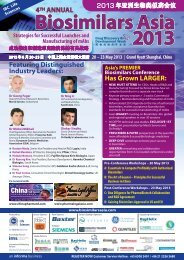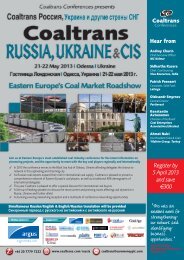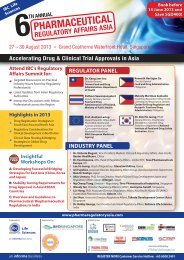Cell Line Development & Engineering
Cell Line Development & Engineering
Cell Line Development & Engineering
You also want an ePaper? Increase the reach of your titles
YUMPU automatically turns print PDFs into web optimized ePapers that Google loves.
Tuesday, May 21, 2013 (continued)<br />
12:55 Chairman’s Remarks<br />
Andy Lin, Ph.D., Process Research & <strong>Development</strong>, Genentech, Inc.<br />
Approaches to Improve <strong>Cell</strong> <strong>Line</strong> <strong>Development</strong> Efficiencies,<br />
Resources and Timelines – What is the Impact<br />
1:00 CASE STUDY • UNPUBLISHED DATA Strategies to Fast/Lean POC and<br />
Risk Mitigation<br />
Fast/lean to PoC is highly desired for drug development. However, fast/lean<br />
cell line generation could potentially result in the identification of clonal cell<br />
lines that are only suitable for early-phase development and result in the<br />
need to change cell lines for commercial development, which can pose a<br />
significant challenge in demonstrating consistency of processes/products. In<br />
this presentation, we share recloning case studies as a potential mitigation<br />
strategy to the risks associated with fast/lean to PoC approaches.<br />
Luhong He, Ph.D., Senior Research Scientist, Eli Lilly and Company<br />
1:30 Streamlining Antibody <strong>Development</strong> Using Large Scale,<br />
CHO Transient Gene Expression (TGE) Followed by Rapid<br />
Production of CHO Stable Pools<br />
Antibody production for early stage antibody development activities is<br />
commonly conducted using transiently transfected HEK cells to produce<br />
adequate quantities of antibody for characterization, while later stage<br />
screening and biomanufacturing rely on CHO-based stable cell lines.<br />
Migration from HEK to CHO cell backgrounds can lead to manufacturing<br />
challenges and changes in post translational modifications that can alter<br />
the antibody’s therapeutic potential. The time line of antibody development<br />
can be greatly streamlined using large scale transient gene expression<br />
(TGE) directly within CHO cells. CHOS cells can be transfected with >95%<br />
transfection efficiency and cell viability using MaxCyte flow electroporation.<br />
MaxCyte transiently transfected CHO cells produce antibody titers > 400<br />
mg/L, enabling greater than 1 gram of protein from 1g/L.<br />
James Brady, Ph.D., MBA, Director of Technical Applications, MaxCyte<br />
2:00 CASE STUDY • UNPUBLISHED DATA Accelerating <strong>Cell</strong> <strong>Line</strong> Screening and<br />
Selection Using a Multiplexed 24 Well Microbioreactor and<br />
Streamlined Purification<br />
Abstract not available at time of print. Please visit<br />
www.IBCLifeSciences.com/<strong>Cell</strong><strong>Line</strong> for updates.<br />
Jessica Wuu, Ph.D., M.S., Senior Scientist, Process Sciences,<br />
Abbott Laboratories<br />
2:30 CASE STUDY • UNPUBLISHED DATA Faster Upstream <strong>Development</strong> for<br />
Therapeutic Proteins: The Contribution of the GS-KO Host<br />
<strong>Cell</strong> <strong>Line</strong><br />
The GS Gene Expression System is widely used for cGMP manufacturing<br />
of therapeutic proteins using mammalian cells. Currently, thirteen licensed<br />
products are manufactured using the GS System. Although the system is<br />
well established, Lonza is continually improving the GS System. Recent<br />
improvements have focussed on a number of areas including reducing<br />
the time for cell line development. The latter was achieved partly through<br />
introduction of a GS-knockout version, CHOK1SV GS-KO, of its standard<br />
CHO host. This talk describes some of work to develop and characterise<br />
the new host cell line, along with comparative performance data from 10 L<br />
bioreactor cultures, and the benefits from switching to the new host.<br />
Andrew Racher, Ph.D., Head of Process <strong>Development</strong> Sciences,<br />
Lonza Biologics plc, United Kingdom<br />
3:00 Networking Refreshment Break and Poster/Exhibit Viewing<br />
Premier Publication:<br />
Media Partners:<br />
<br />
Tribute to the Legacy of Marty Sinacore –<br />
Reflections and State-of-the-Art Advances<br />
3:30 Chairman’s Remarks<br />
Sadettin S. Ozturk, Ph.D., Senior Director, Head of Process <strong>Development</strong>,<br />
MassBiologics<br />
3:45 A Tribute to Marty Sinacore<br />
Marty Sinacore has been one of the contributors of<br />
developing today’s technology used for mammalian cell<br />
based production. Besides being a great scientist Marty has<br />
been the mentor of countless young scientists that now are<br />
part of the backbone of our community. In this<br />
presentation, Tim and Thomas highlight some of<br />
Marty’s work and how it influenced the way we do cell<br />
based manufacturing today.<br />
Tim Charlebois, Ph.D., Vice President,<br />
Technology & Innovation Strategy, Pfizer Inc.<br />
Thomas Ryll, Ph.D., Senior Director, <strong>Cell</strong> Culture <strong>Development</strong>, Biogen Idec<br />
4:30 UNPUBLISHED DATA <strong>Development</strong> of a Custom <strong>Cell</strong> <strong>Line</strong> Toolbox<br />
with Diverse Product Quality Attributes<br />
Although the simplicity of having a single, well characterized host upon<br />
which to initiate cell line engineering has many advantages, a one size<br />
fits all approach does have its drawbacks. The range of product quality<br />
attributes achievable will be limited by the intrinsic phenotype of said host<br />
and may not overlap with the optimum profile for a given therapeutic. With<br />
the increased sophistication of engineering tools enabling precise genome<br />
editing or mRNA depletion, it’s now relatively straight forward to develop<br />
modified hosts with tailored made phenotypes. The end result being the cell<br />
line engineer can develop a “toolbox” of varied hosts that can be employed<br />
to insure that critical quality attributes or biosimilarity is achievable.<br />
Scott Estes, Ph.D., Director, <strong>Cell</strong> Culture <strong>Development</strong>, Biogen Idec<br />
5:00 The Impact of ‘Omics Technologies on Process<br />
<strong>Development</strong> – The Promise and the Reality<br />
It was just over 10 years ago that the use of ‘omics technologies started<br />
to make their way into bioprocess development. For many early adopters<br />
of the technology, the promise was a better fundamental understanding<br />
of cell biology that would lead to engineered cell lines that would be<br />
optimized for production of secreted biotherapeutics. That isn’t what<br />
happened, however.<br />
Mark Melville, Ph.D., Senior Director, Bioprocess <strong>Development</strong>,<br />
Epirus Biopharmaceuticals<br />
5:30 CASE STUDY • UNPUBLISHED DATA Preservation of a Balanced <strong>Cell</strong><br />
Culture Environment for Fed-Batch Processes<br />
This presentation demonstrates with examples the effect of cell culture<br />
imbalance on cell growth and productivity, as well as specific solutions to<br />
remedy these issues. A simple solution to revive the drop in cell viability<br />
observed during the late stage of cell culture is also discussed. Finally, a<br />
systematic approach of medium feeding to achieve high cell density, high<br />
viability, and high titer process is also described.<br />
Yen-Tung Luan, M.S., Associate Research Fellow, Bioprocess R&D, Pfizer Inc.<br />
“By narrowly targeting the technologies used<br />
at the border of R&D of biotherapeutics, this event provides<br />
an intensive 3-day review of current, valuable information<br />
for this highly specialized group.”<br />
- Pam Hawley-Nelson, Ph.D., Associate Director,<br />
Process <strong>Cell</strong> Culture, MedImmune<br />
For up-to-date program information and new abstracts, visit: www.IBCLifeSciences.com/<strong>Cell</strong><strong>Line</strong> 5




